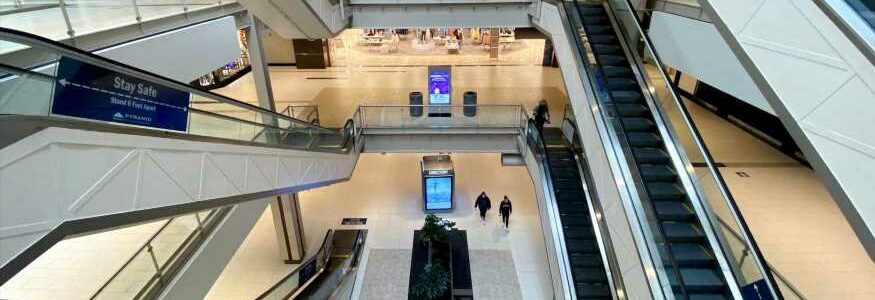
Mall vacancies jump at fastest pace on record, hitting new high, as retailers cull store counts
- The vacancy rate for regional malls in the U.S. reachedrecord 11.4% in the first quarter, from 10.5% in the fourth quarter, according to Moody's Analytics' commercial real estate division.
- The 90 basis-points increase marked the highest the firm has ever seen, surpassing the record 80 basis-point spike in the first quarter of 2009.
- "Malls are absolutely still on the ropes," said Moody's Victor Calanog.
If you noticed more darkened windows and empty stores at the mall recently, you're not alone.
The vacancy rate for regional malls in the United States hit a record 11.4% in the first quarter of 2021 from 10.5% in the fourth quarter of 2020, according to Moody's Analytics' commercial real estate division.
The 90 basis-points increase marked the highest the firm has ever seen, surpassing the record 80 basis-point spike in the first quarter of 2009, in the thick of the Great Recession.
"Malls are absolutely still on the ropes," said Victor Calanog, lead of the commercial real estate economics division within Moody's. "They were on the ropes even before Covid. … It's almost passe now to say that we have a record vacancy rate for malls because we've been breaking that record all year."
The U.S. has about 1,000 malls, according to the commercial real estate services firm Green Street. Moody's tracks about 700 of them for its analysis.
Shopper traffic to many enclosed malls, often situated in the suburbs, has dropped steadily over the years, with Americans spending more online. This pattern was only accelerated by the global health crisis. Many of the retailers within malls, including department stores, have increasingly struggled to stay relevant with their customers. Last year saw several mall-based businesses — including J.C. Penney, Neiman Marcus, Lord & Taylor, Brooks Brothers and J.Crew — file for bankruptcy protection.
While other commercial real estate sectors like multifamily apartment buildings are showing better progress, retail remains the most pressured, Moody's found in its latest quarterly report.
Industrial real estate has been the most resilient property type, with demand for warehouses that store goods and fulfill e-commerce orders surging. Rents for warehouse and distribution properties across the country have not turned negative, so far, during the duration of the pandemic, Calanog said.
Office space, like retail, continues to see heightened vacancy rates and declining rents. Many businesses are still grappling with what the future of work space is going to look like. Companies are considering culling their office footprints and allowing employees to embrace working at home, at least part of the time.
Forty-eight of the 79 U.S. metro areas that Moody's tracks suffered effective office rent declines in the first quarter. Among the hardest hit areas were Charleston, South Carolina, down 3.5% quarter over quarter; New York, down 1.8%; and San Francisco, down 1.6%.
Within the retail sector, 40 of the 77 metros recorded a decline in effective rent during the first quarter, Moody's found. Here, retail is only representative of neighborhood and community shopping centers, not indoor malls, the firm noted.
The vacancy rate for these retail properties (again, not including malls) was 10.6% during the latest period, up slightly from 10.5% during the fourth quarter.
"It's an ongoing balance between store closures versus openings," Calanog said about the retail industry. "We want to be fair, there are companies that are opening stores. … But right now we're losing space, and that's what the data reflects."
Store growth in retail today has largely been concentrated in the off-price and discount space, with businesses like Dollar General, Lidl, TJ Maxx, Burlington and Five Below plotting bigger expansions. Beauty businesses Ulta and Sephora are also still opening shops, anticipating a strong post-pandemic rebound in visits to brick-and-mortar stores.
But that growth won't always be enough to offset decay elsewhere.
In a separate report released this week, UBS predicted in a base-case scenario that there will be roughly 80,000 retail store closures nationwide in the next five years, impacting about 9% of all retail stores. Apparel, sporting goods and office supplies shops are expected to drive a large share of closures, UBS said.
It counted 115,000 shopping centers — a figure that includes strip centers, malls, outlet and other lifestyle centers — across the U.S. at the end of 2020, compared with 112,000 in 2010 and 90,000 in 2000.
— CNBC's Nate Rattner contributed to this data visualization.
Source: Read Full Article